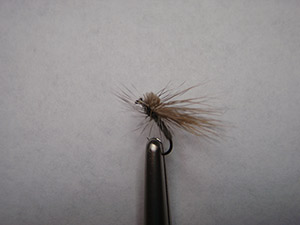HOT CREEK CADDIS
ERIC OTZINGER
This fly is for all those members going to fish hot creek this month. It’s a very simple caddis pattern and is very effective for slow water caddis hatches that occur on hot creek throughout the fishing season. But where it really excels is when the water gets a little rougher at the head of a run. You can toss the fly in there and it is still floating when it comes on out - unless a fish has hit it of course. Designed by Eric Otzinger perhaps one of the best tiers in the world. This pattern sits low to the water and simulates the small gray sedge caddis that is prevalent on hot creek; which is a slow water spring creek. It can also be used as a mayfly emerger during pale morning dun and blue-winged olive hatches.
PATTERN
HOOK – light wire dry fly. Mustad #R50-94840 or Tiemco # 100 #16-#22. THREAD – 8/0 medium to dark gray.
BODY – medium to dark gray or other colors to match hatching naturals.(I used superfine).
Wing – coastal deer hair or very fine elk. HACKLE – grizzly neck.HOW TO TIE
- Debarb- mount hook – start your thread just before the bend of the hook – dub an ever so small taper from the rear of the hook shank to just in front of the eyelet. (About one and a half eyelet space from the eyelet).
- Prepare the deer hair wing by removing all the under fur with a small comb then put it in a hair stacker with the tip first to align the tips (Don’t forget to use your cruddy scissors to cut the deer hair – cause it will dull your good ones). Tie the deer hair wing in about ¾ up the shank – right about where you stopped your dubbing with the tips facing the rear of the hook it should extend just a little past the bend of the hook – but don’t clip your excess deer hair yet you will need it to help lift it as you wrap your hackle.
- Tie in your grizzly hackle with the dull side down and it should be one and a half to two times the hook gape and wind parachute style underneath the wing and butt ends. (Between the wing/butts and the body) make two to four turns, depending on the size of the fly and tie off.
- Pull the deer hair butts and hackle feather back, whip finish the head and cut off the excess deer hair leaving a small stub similar to an elk hair caddis.


